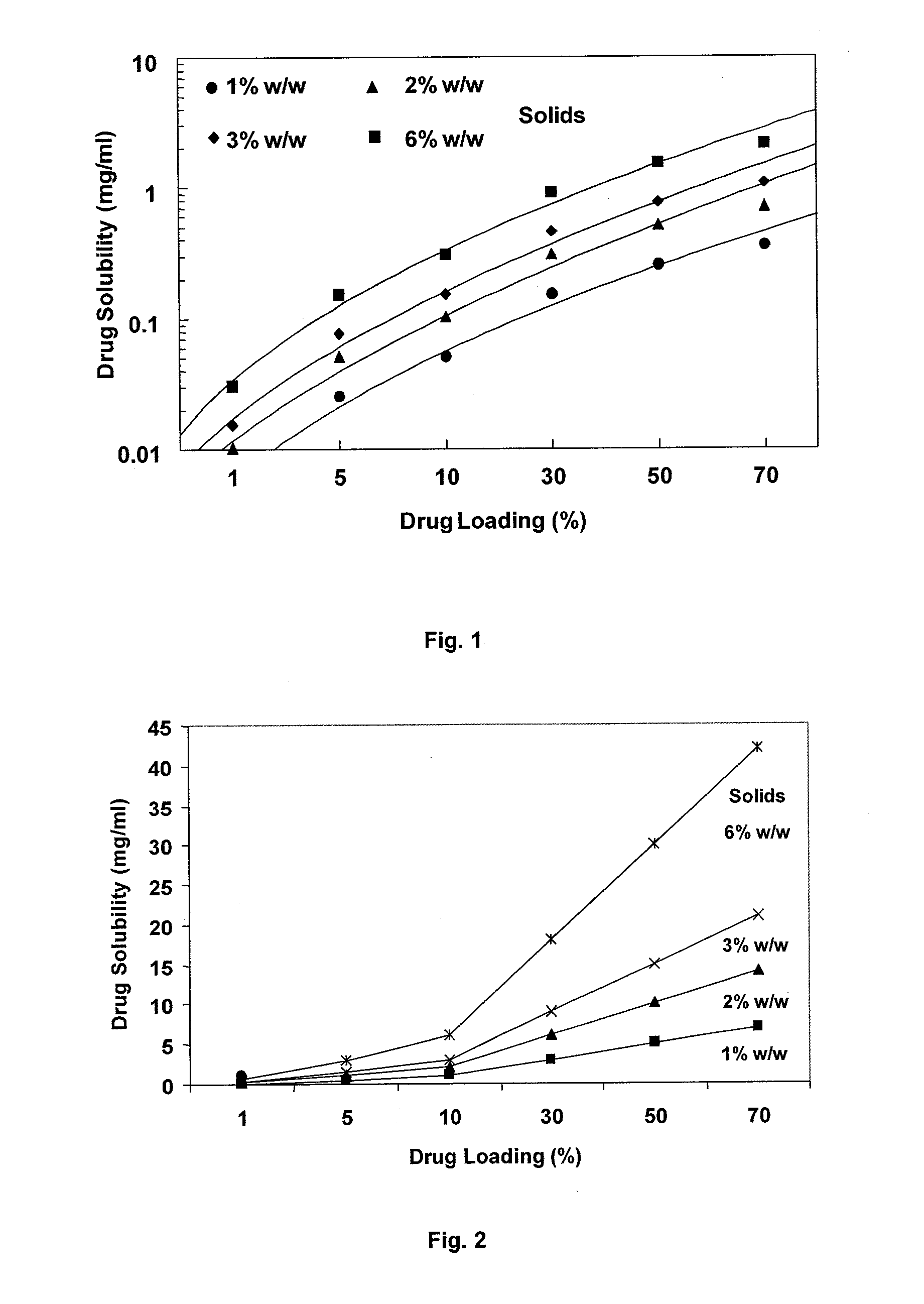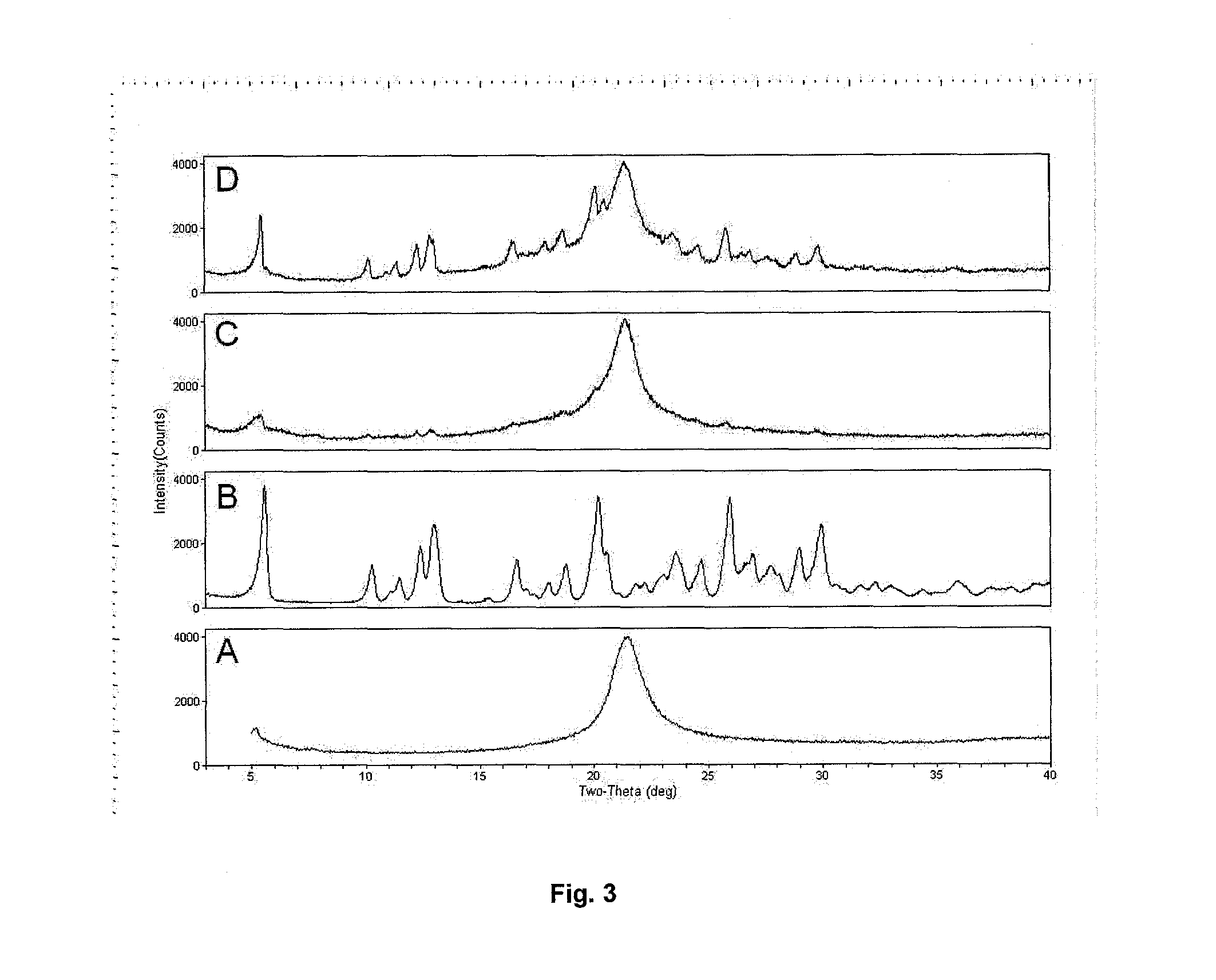Dry powder formulations of particles that contain two or more active ingredients for treating obstructive or inflammatory airways diseases
- Summary
- Abstract
- Description
- Claims
- Application Information
AI Technical Summary
Benefits of technology
Problems solved by technology
Method used
Image
Examples
example 1
[0153]Preparation of a Dry Powder Formulation Comprising Spray-Dried Particles that Contain Formoterol and Budesonide
[0154]A dry powder formulation comprising spray-dried particles that contain formoterol fumarate and budesonide were prepared by a two-step manufacturing process.
[0155]In the first step, 1.38 g of distearoylphosphatidylcholine (DSPC) (Genzyme Pharmaceuticals, Cambridge, Mass., USA), and 119.6 mg calcium chloride (J T Baker) were dispersed in 164 g of hot deionised water (T=70° C.) using an ULTRA-TURRAX™ high shear mixer (model T-25) at 10,000 rpm for about 1 minute. The resulting DSPC / CaCl2 dispersion was then cooled in an ice bath. 98 mg of micronised formoterol fumarate (Industriele Chimica s.r.i, Italy) was added while mixing. The formoterol has a water solubility of about 1 mg / ml, and as such, dissolves in the aqueous phase. The resulting formoterol / DSPC / CaCl2 dispersion was then passed through a high pressure homogenizer (AVESTIN EMULSIFLEX-C5™ high pressure homo...
example 2
[0158]Preparation of Dry Powder Formulations Comprising Spray-Dried Particles that Contain Fixed Dose Combinations of Micronised Indacaterol Maleate Crystals Coated with Amorphous Glycopyrrolate and Phospholipid
[0159]In this Example inhalable dry powders comprising indacaterol maleate, glycopyrrolate, and excipients (distearoylphosphatidylcholine (DSPC), calcium chloride, and trehalose) were manufactured by spray drying an emulsion-based feedstock.
[0160]The feedstock was prepared by mixing an individually prepared vehicle emulsion and a drug annex solution.
[0161]The vehicle emulsion was prepared by emulsifying perfluorooctyl bromide (PFOB, perflubron) in an aqueous dispersion of DSPC containing dissolved CaCl2. A two-step process was employed in which a coarse emulsion was prepared with a ULTRA-TURRAX™ high shear mixer, followed by homogenization through an AVESTIN C50™ homogenizer. The resultant vehicle emulsion was a stable oil-in-water emulsion with a median emulsion droplet size...
example 3
[0166]Physicochemical Properties of a Dry Powder Formulation Comprising Spray-Dried Particles that Contain Fixed Dose Combinations of Indacaterol Maleate and Glycopyrrolate
[0167]In this Example the physicochemical properties (e.g. morphology, primary particle size) of the powders prepared according to Example 2 were measured.
[0168]Scanning electron microscopy (SEM) was used to qualitatively assess the morphology of the spray-dried particles. Samples were mounted on silicon wafers that were then mounted on top of double-sided carbon tape on an aluminium SEM stub. The mounted powders were then sputter-coated with gold:palladium in a DENTON™ sputter-coater for 60 to 90 seconds at 75 mTorr and 42 mA, producing a coating thickness of about 150 Å. Images were taken with a PHILIPS™ XL30 ESEM™ scanning electron microscope operated in high vacuum mode using an Everhart-Thornley detector to capture secondary electrons for the image composition. The accelerating voltage was set at 20 kV using ...
PUM
| Property | Measurement | Unit |
|---|---|---|
| Length | aaaaa | aaaaa |
| Length | aaaaa | aaaaa |
| Length | aaaaa | aaaaa |
Abstract
Description
Claims
Application Information
 Login to View More
Login to View More - R&D
- Intellectual Property
- Life Sciences
- Materials
- Tech Scout
- Unparalleled Data Quality
- Higher Quality Content
- 60% Fewer Hallucinations
Browse by: Latest US Patents, China's latest patents, Technical Efficacy Thesaurus, Application Domain, Technology Topic, Popular Technical Reports.
© 2025 PatSnap. All rights reserved.Legal|Privacy policy|Modern Slavery Act Transparency Statement|Sitemap|About US| Contact US: help@patsnap.com



